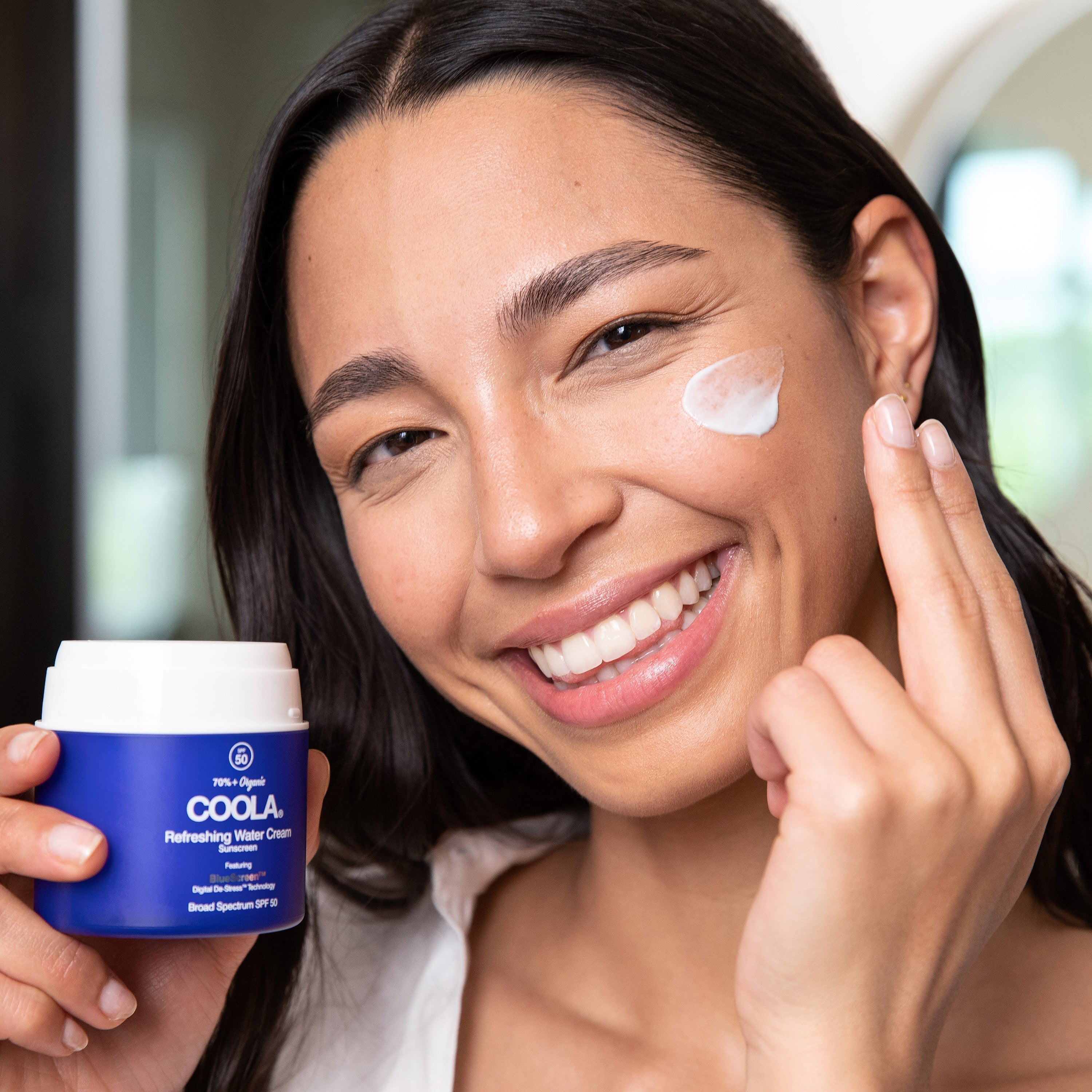
Should You Apply Sunscreen Before or After Moisturizer: Here's What Dermatologists Recommend
You might be doing everything right with your skin care routine — cleansing, hydrating, and protecting — but if you are not applying your products in the correct order, they might not be working effectively for your skin.
The question "Sunscreen before or after moisturizer” comes up constantly and for good reason. The catch? The type of sunscreen used will depend on whether to apply it before or after.
Dermatologists often emphasize the importance of sunscreen,1 explaining that sunscreen helps prevent premature signs of aging and shields the skin from UVA exposure.
This guide will direct you through the correct application order, address common concerns, provide tips on layering without pilling, and help you determine when to apply moisturizer with SPF.
Should You Apply Sunscreen or Moisturizer First?
Chemical sunscreen is best applied before moisturizer so it can absorb into the skin, while mineral sunscreen should be layered on after moisturizer since it works as a protective barrier.
There is no one-size-fits-all, but a scientifically correct order depending on the type of SPF. When products don't sit well together, common concerns like absorption, layering, and pilling are completely normal. Check out COOLA’s sunscreen pilling guide for tips on why it happens and how to prevent it.
Understanding the Difference: Chemical vs Sheer Mineral Sunscreen
Understanding the difference between chemical and mineral sunscreen is crucial for application order.
Chemical Sunscreen Goes Before Moisturizer
Chemical sunscreen offers your skin protection through active ingredients like avobenzone, octocrylene, or homosalate. We recommend you apply it before moisturizing, to clean and dry skin, because the chemical needs to be absorbed into your skin for it to be effective. Then wait for two to five minutes for the sunscreen to absorb and provide protection to your skin.
Mineral Sunscreen Goes after Moisturizer
Sheer mineral sunscreen is designed to be applied after moisturizer. These formulas sit on the surface of the skin and act as a physical barrier, helping to reflect UV rays. For best results, allow your moisturizer to fully absorb before applying mineral sunscreen. This helps create a smooth surface and reduces the risk of pilling or uneven coverage.
Tips For Layering Without Pilling
Pilling happens when skincare or sunscreen products don’t absorb properly and begin to ball up on the surface of your skin — often due to layering too quickly or product incompatibility.
Here’s how to avoid it:
- Wait between layers: After applying each product, give your skin two to five minutes before applying the next step.
- Apply gently: Don’t rub or pat mineral SPF aggressively. Instead, use light, sweeping motions to help the product settle evenly.
- Choose lightweight formulas: Heavy silicones are a common cause of pilling. Opt for lighter moisturizers and mineral sunscreens designed to layer well.
- Use high-quality mineral SPF: Formulas that are better stabilized and designed for layering are less likely to pill.
For more tips and troubleshooting, check out our full guide: How to Stop Your Sunscreen From Pilling.
Using a Moisturizer with SPF: Is It Enough?
On busy mornings, a face moisturizer with SPF can be a convenient way to streamline your skincare routine. But convenience doesn’t always mean full protection.
Most people don’t apply the right amount of sunscreen to effectively protect their skin — and dermatologists agree. In a JAMA Dermatology survey of 165 dermatologists, 99% said they believe their patients underapply sunscreen, which reduces its effectiveness and leaves skin vulnerable to damage.2
That said, SPF moisturizers can still play a role in your routine — especially for indoor days, as a base under mineral sunscreen, or when reapplication isn’t always realistic. COOLA's Refreshing Water Cream offers a hydrating solution that blends skincare and sun protection — perfect for those with dry skin. Lean more towards oily? Try COOLA’s lightweight SPF moisturizers for oily skin, which help minimize breakouts while shielding skin from environmental stressors.
Refine Your Routine with Multitasking Products
Streamline your skincare with multitasking formulas that protect and perfect. COOLA’s Dew Good Illuminating Serum SPF 30 is a 3-in-1 organic serum that hydrates, brightens, and protects your skin with a dewy, radiant finish.
Looking for lightweight, customizable coverage? COOLA’s anti-aging SPF drops are powered by plant-based technology and help defend your skin not only from UV rays, but also from blue light, infrared, and environmental pollutants.
Pro tip: For best results, apply SPF drops directly to clean skin before layering makeup. Blending them into the foundation can dilute the SPF’s effectiveness.
Frequently Asked Questions
Do you apply sunscreen before or after moisturizer?
It depends on the type of sunscreen you are using. Chemical sunscreen should be applied to clean, dry skin before moisturizer so it can absorb properly. Mineral sunscreen should be applied after moisturizer, since it sits on top of the skin to help reflect UV rays.
Can I use a moisturizer with SPF instead of sunscreen?
Yes — but for better protection, we recommend pairing it with a dedicated SPF. SPF moisturizers can work well for indoor days, limited sun exposure, or as a base layer under mineral sunscreen. For extended time outdoors, always use a broad-spectrum SPF 30+ sunscreen and reapply every two hours for optimal coverage.
How long should I wait between moisturizer and sunscreen?
Give each product 2 to 5 minutes to absorb before applying the next layer. This reduces pilling and ensures each formula performs as intended.
Does the order change if I wear makeup?
No. Apply sunscreen (chemical or mineral) before any makeup. For extra tips on layering, check out COOLA’s guide to layering makeup and sunscreen.
Get the Sun Protection You Need in the Right Order
At COOLA, we’re all about making sun protection feel effortless. Applying your products in the right order helps keep your skin hydrated, happy, and protected from the rays that cause damage over time.
From lightweight moisturizers to sheer mineral sunscreens that disappear into your skin, we’ve got SPF options that fit seamlessly into your routine. Find your COOLA favorite and make daily sun protection a part of your day that you actually look forward to.
Sources:
- Dermatology and Skin Health. “The Importance of Sunscreen.” Dermatology and Skin Health, May 1, 2021. https://dermskinhealth.com/the-importance-of-sunscreen/
- JAMA Dermatology. “Perspectives on Sunscreen Use: A Survey of US Dermatologists.” JAMA Dermatology, October 1, 2016. https://jamanetwork.com/journals/jamadermatology/fullarticle/2569293





